[VTG] HPCVTG: Toward Human Perception-Centric Video Thumbnail Generation
[VTG] HPCVTG: Toward Human Perception-Centric Video Thumbnail Generation
- paper: https://dl.acm.org/doi/10.1145/3581783.3612434
- github: https://github.com/yangtao2019yt/HPCVTG (깡통)
- ACM MM 2023 accepted (인용수: 167회, 24’-07-23 기준)
- downstream task: Video Thumbnail Generation Task
1. Motivation
- Online video를 시청하는 user가 항해(서칭)하는 과정에서 video thumbnail은 user의 attention을 취득하는데 중요한 역할을 수행한다.
- 하지만 매력적이고 충분한 정보를 담은 video thumbnail을 취득하는데 2가지 어려움이 존재한다.
- 미적인 기준들 간의 충돌(Layout Visual Balance vs. Symmetry)로 인해 미적인 원칙들 골고루 균형있게 찾기가 어려움
- 핵심 image frame (keyframe)과 해당 text paired data가 부재
- 위 두가지 문제를 해결하는 방법을 고안해보자!
2. Contribution
- 디자인 원칙을 만족하는 thumbnail을 생성하는 새로운 기법을 제안
- Layout의 visual balance를 만족할 것
- Element간 overlap을 피할것
- Large-scale video thumbnail design dataset (10K videos)를 제안함
- video당 10개씩 총 100K thumbnail image존재
- 2K는 human feedback으로 라벨링
- video당 10개씩 총 100K thumbnail image존재
- Few-shot Learning (MAML)기반의 rapid adaptation을 통해 다양한 human preference를 빠르게 반영 가능함
- MAML + Human Feedback의 새로운 연구방향 제시
- 모델: LayoutGAN++ (VAE)
- MAML: Few-shot learning으로, human annotation cost를 줄일 수 있음
- MAML + Human Feedback의 새로운 연구방향 제시
3. HPCVTG
-
Preliminaries
-
Automatic Video Thumbnail Generation
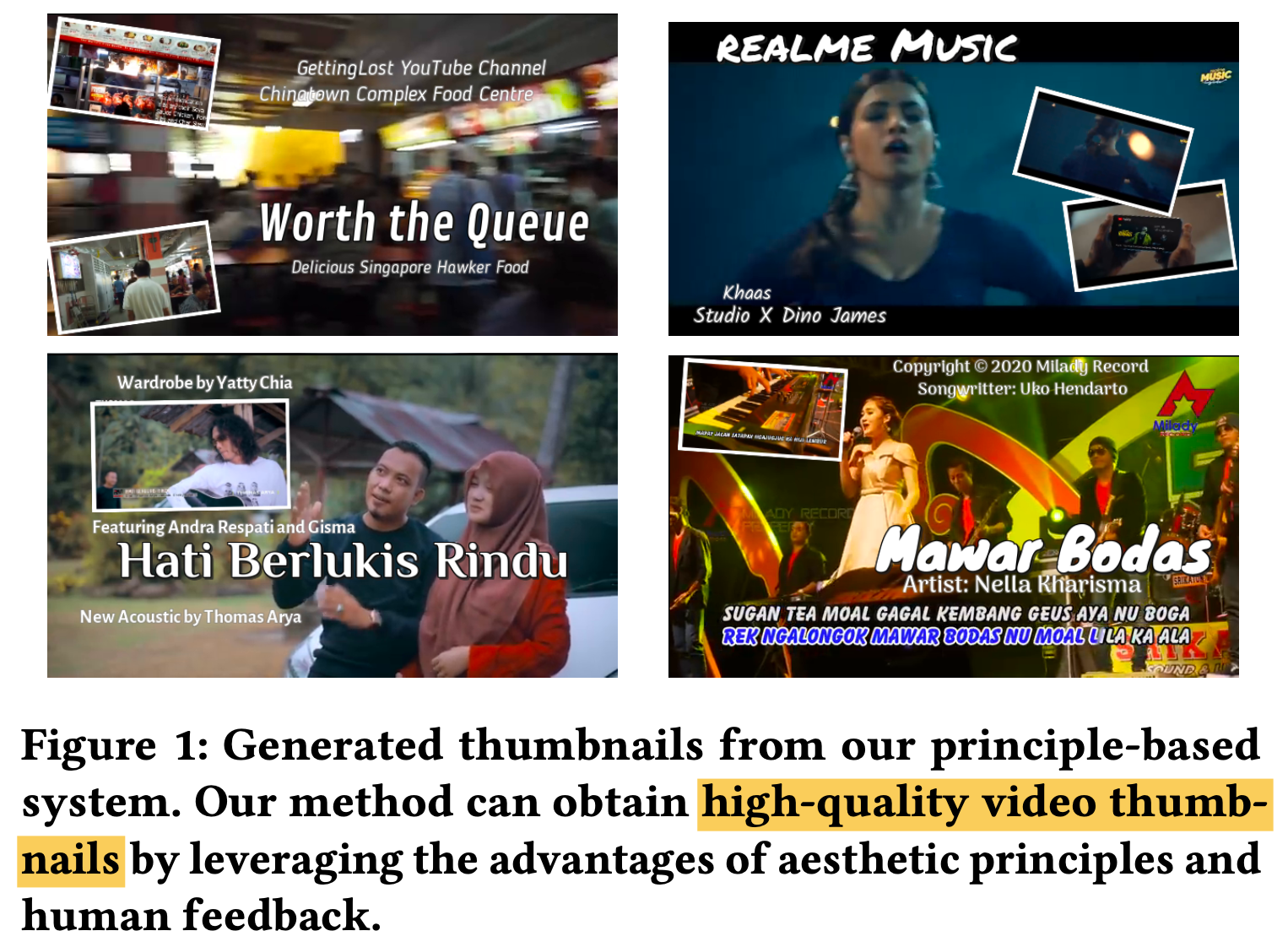
-
비디오의 내용을 요약하는 대표성이 있는 커버 page를 생성하는 task
-
목적함수

-
$\Epsilon^{bg}$: Salient Object for the background image
-
$\Epsilon^{fg}$: Keyframe ($e^{fr}_i$) + key text ($e_i^{text}$)의 집합

-
$\Epsilon^{fr}$: keyframes

- Elements
- class: l=[‘title’, ‘subtitle’, ‘frame’, ‘background’]
- bbox: (x,y,w,h,r) (r: rotation angle)
- Elements
-
$\Epsilon^{text}$: Key texts
-
-
-
-
Model-Agnostic Meta-Learning (MAML)
-
목적: 좋은 초기 model parameter를 학습하기 위함
- 새로운 task (new user, new preference)에 빠르게 적응하기 위함
-
목적함수

- $\beta$: learning rate
- $D_T^{val}$: T task의 검증셋
- $D_T^{train}$: T task의 학습셋 (few-shot)
- $\theta^K$: K iteration adaptation된 model weight
-
-
-
HPCVTG
-
overall architecture
- 세 가지 모듈로 구성

-
Thumbnail elements extraction
-
Key texts extraction
-
Video content에 어울리는 title과 description의 words, phrases를 ChatGPT를 통해 추출
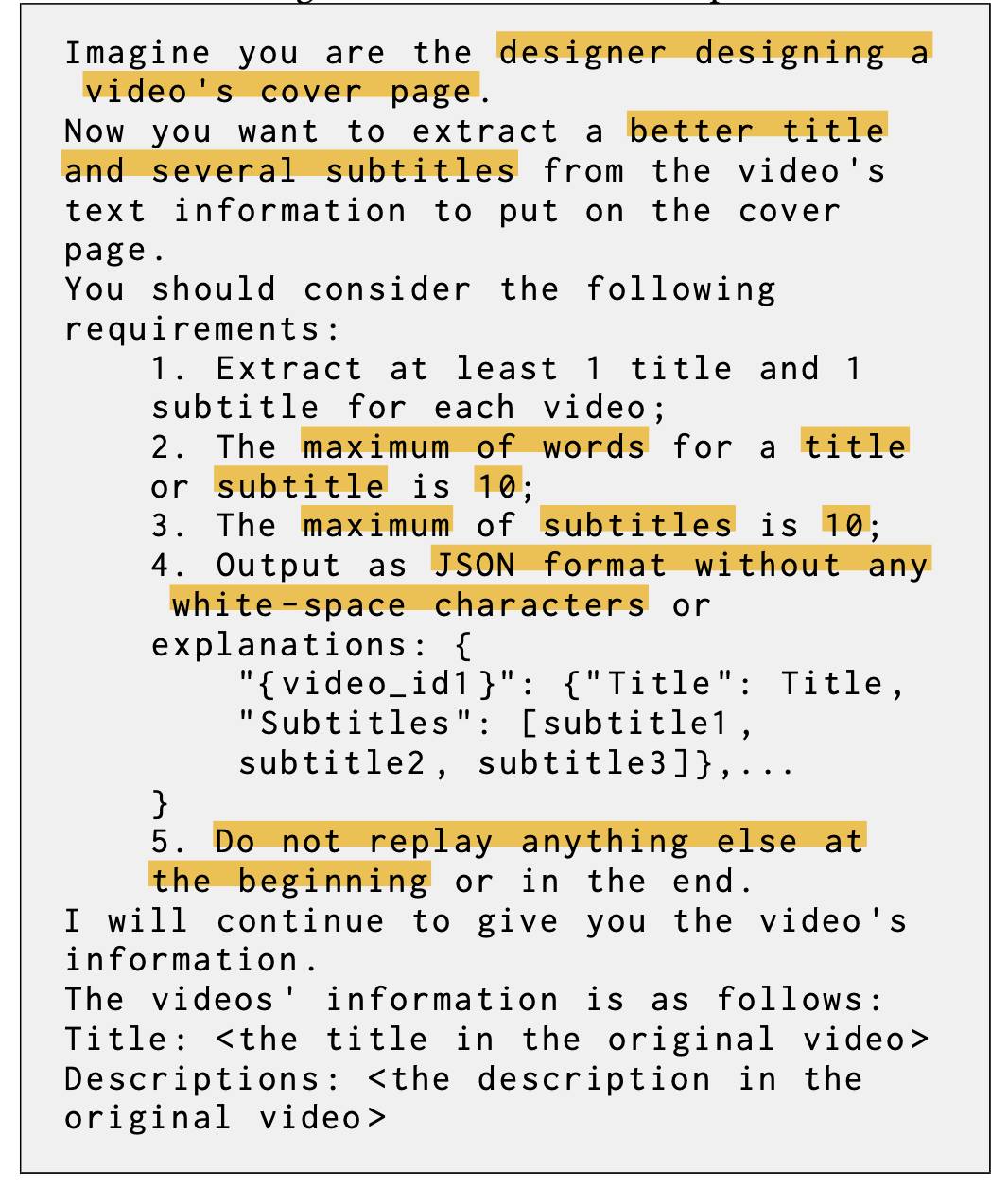
-
특수문자는 제거
-
-
Key frames extraction
- Video를 20초에 1장씩 frame을 추출하고,
- Key text와 Clip기반으로 similarity score가 제일 높은 frame을 추출
-
-
Aesthetic Principles
-
미적 기준은 주관적이고, 좋은 결과에 대한 분산이 크기 때문에 m개의 원칙을 세워 이를 충족하도록 함

-
P: Design Constraint
-
L: Design Principle
-
n=5가지 중요 원칙
-
Background covered: 전체 background frame 중에 생성된 layout bbox가 얼마나 위치하는지를 loss로 정의

- F: background area
- $e_i$: i번째 element
-
Rotation Diversity
-
Rotation의 출력 결과가 획일적인걸 방지하고자, 분산값을 늘리도록 loss로 정의

-
-
Intrusiveness: 생성된 layout이 background image의 얼굴 영역을 blocking하지 않도록 loss를 정의

-
Border-Crossing: 생성된 layout이 Background frame의 경계영역을 넘지 않도록 loss로 정의

-
-
기타 2가지 고려한 사항
- Saliency + semantic information 모두 활용 (semantic segmentation score + saliency score)
- Predefined font size, font candidate, font style를 가지고 text element를 search할 때마다 랜덤하게 생성
- Font size
- title: [0.12H, 0.18H]
- subtitle: [0.068H, 0.084H]
- Font candidate
- Title: 23개
- Subtitle: 42개
- Font size
-
-
Objective Function
-
Visual Balance: 전체 element의 “gravity”가 중심을 향하도록 loss를 설계 (Gravity: 모든 요소의 중점의 평균)

- $C_m$: Frame의 중점
- $C_o$: Layout의 중점 ($a_e=h_ew_e$)
-
Compactness: Element가 corner에 산발되지 않도록 class 중점을 기준으로 regularization loss을 부여

-
Attractiveness: Watching poster라는 논문 그대로 인용 $\to$ [46]
-
-
Constraints
-
Element Non-overlapping: 두 keyframe내 요소간의 IoU upperbound를 설계

-
Saliency Unobstructed: Background의 saliency영역을 forground elemnt가 overlap하지 않계 설계

-
-
Searching Algorithm: GA (Genetic Algorithm) 사용
-
-
Thumbnail Neural Generator
-
Architecture: Clip-t, Clip-I, Mask-RCNN, LayoutVAE 사용
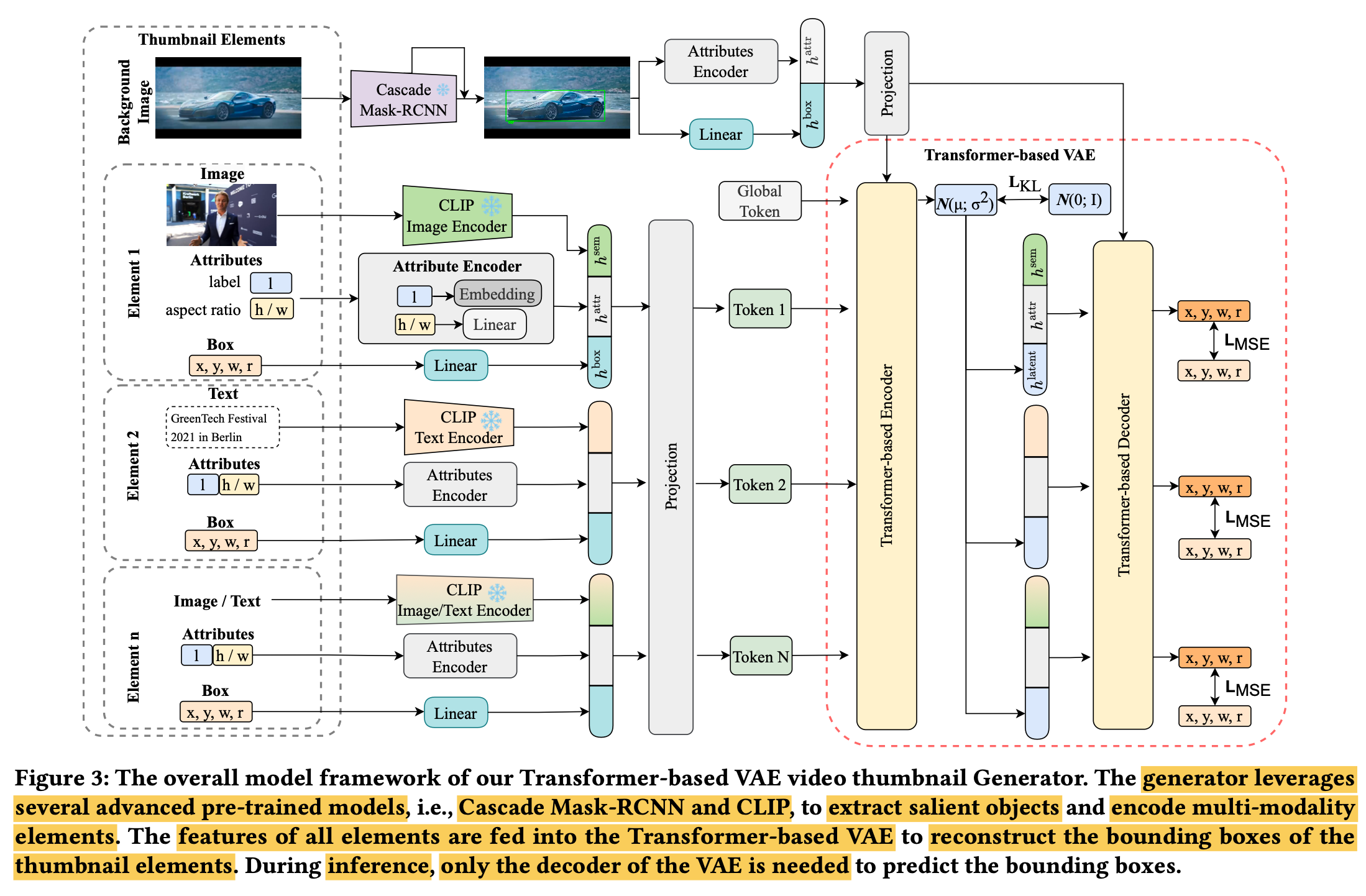
-
Forground Element embedding

-
Background embedding: Mask-RCNN의 bbox로 saliency detection

-
LayoutVAE
- input: forground / background embedding
- output: reconstructed bbox


-
Loss

-
-
Total Loss

-
-
Learning with Human Feedback
- 2K개의 비디오에 대해 수행
- 9개 중 3개는 principle-based / 나머지 6개는 random 추출 후, 사람에게 점수를 부여하도록 함
-
Training
-
pretraining: Random + principle based 로 추출한 pseudo preference로 학습
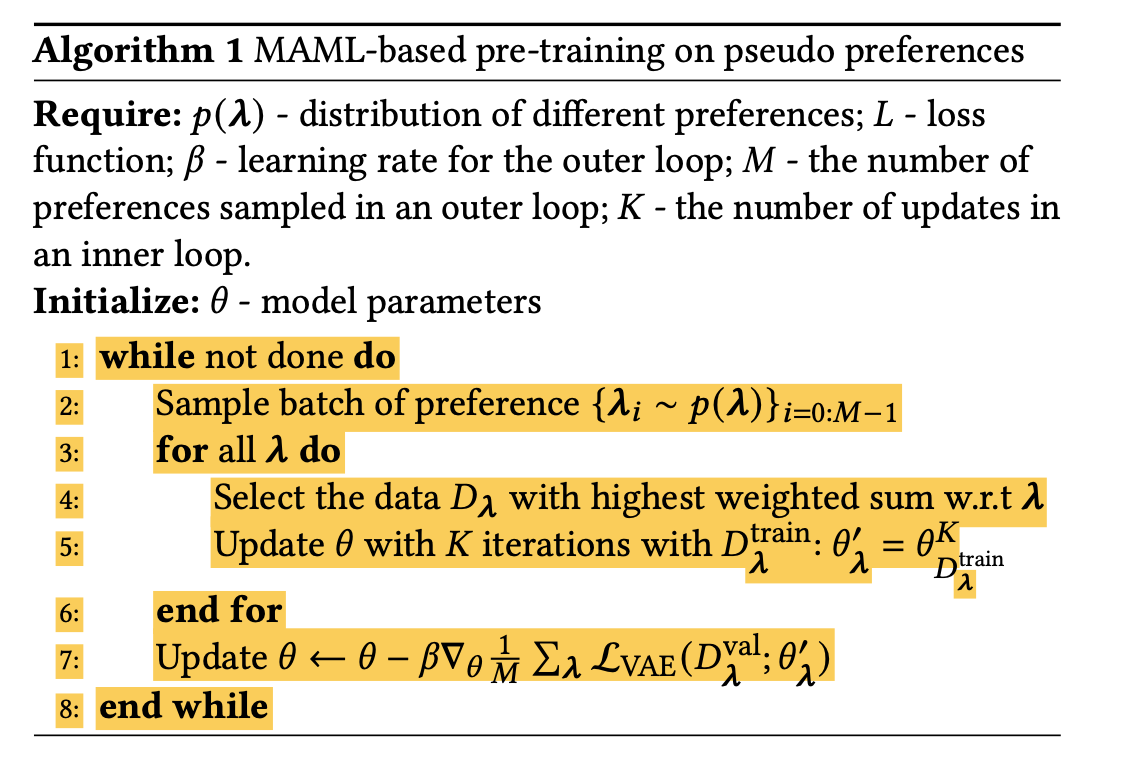
-
finetuning: human preference로 학습
-
4. Experiments
-
정량적 분석

-
정성적 분석
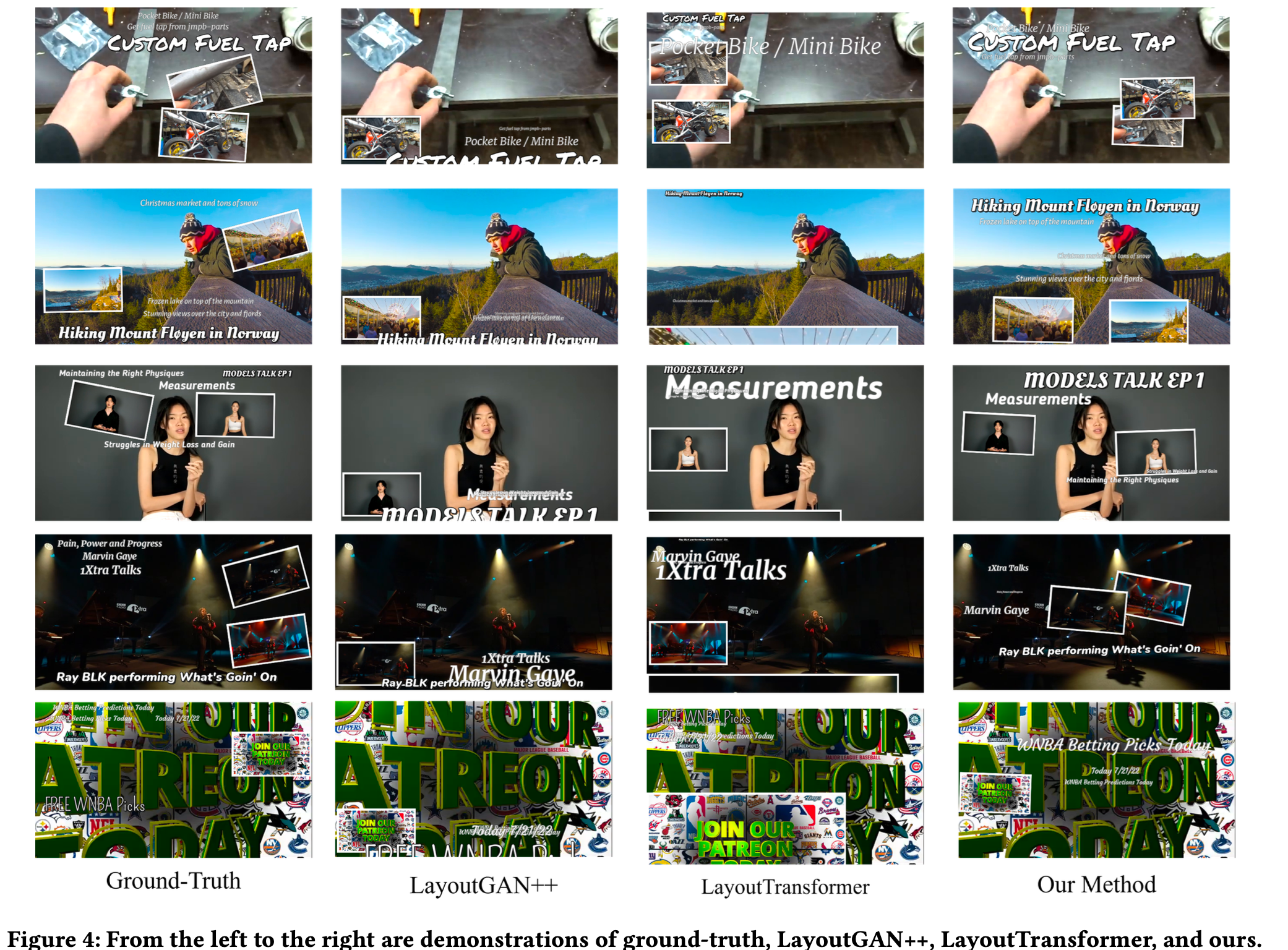
-
Ablation study


